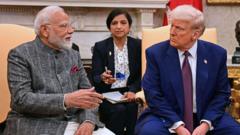Will Trump’s 25% Tariffs Target India, His 'Good Friend'?

Understanding the Implications of US-India Trade Negotiations
The ongoing trade negotiations between the United States and India have garnered significant attention, especially with the looming deadline set by President Donald Trump. As the US government hints at potential tariffs of up to 25% on Indian goods, the stakes are high for both countries. This article delves into the intricacies of these negotiations, the implications of tariffs, and what a trade deal could mean for the future of US-India relations.
The Current Trade Landscape
Trade agreements play a crucial role in shaping the economic interactions between countries. The US and India have been engaged in negotiations aimed at reducing trade barriers and increasing market access. However, these discussions have faced hurdles, particularly concerning tariffs and agriculture. As of August 1, the US has set a deadline for both nations to finalize a deal or face increased import taxes.
Understanding tariffs is essential for grasping the full impact of these negotiations. Tariffs are essentially taxes imposed on imported goods, which can lead to higher prices for consumers and alter trade dynamics. President Trump has frequently criticized India for its high tariffs, calling it a "tariff king" and indicating that these taxes put American businesses at a disadvantage.
The Stakes of Tariffs
The potential implementation of tariffs can have far-reaching consequences. If India fails to secure a trade deal before the deadline, it could face tariffs that significantly impact its economy. Here are some potential effects of such tariffs:
- Increased Costs for Consumers: Higher tariffs mean that imported goods become more expensive, leading to increased prices for consumers in India.
- Impact on Exports: Indian exporters may find it harder to compete in the US market, resulting in decreased sales and potential job losses.
- Retaliation Risks: India may respond with its own tariffs, escalating trade tensions and leading to a tit-for-tat scenario.
Key Points of Negotiation
The negotiations between the US and India have focused on several critical areas, including agriculture, dairy, and tariffs. Both sides have expressed interest in finding common ground, but significant differences remain.
Agricultural Access
One of the main sticking points in the negotiations is agricultural access. The US has been pushing for greater entry into India's agricultural market, viewing it as a significant opportunity for American farmers. However, India has been protective of its agricultural sector, citing concerns about food security and the livelihoods of millions of small farmers.
Indian Commerce Minister Piyush Goyal has emphasized the sensitivity of the agricultural sector, stating that farmers' interests must be safeguarded. This protective stance reflects India's long-standing policy aimed at ensuring food security and supporting local farmers.
Tariffs on Goods
In addition to agricultural access, tariffs on various goods have been a significant topic of negotiation. The US has previously imposed tariffs on certain Indian goods, and discussions have revolved around reducing these tariffs to create a more balanced trade relationship.
Optimism Amidst Challenges
Despite the challenges, both Indian and American officials have expressed cautious optimism about reaching an agreement. US Trade Representative Jamieson Greer has noted that discussions have been constructive, even though the complexities of India's trade policies present obstacles.
As both countries continue to negotiate, the focus remains on finding a balance that satisfies both parties. With a target set to increase bilateral trade to $500 billion, the stakes are high for both nations.
The Importance of Bilateral Trade
Bilateral trade between the US and India has seen substantial growth, with figures reaching approximately $190 billion in recent years. The relationship has evolved, with both countries recognizing the potential for mutual benefit. However, the current trade deficit of $45 billion has become a focal point for President Trump, who aims to reduce this imbalance.
Reducing the Trade Deficit
President Trump’s administration has focused on securing trade deals that open new markets for American goods. The goal is to reduce the trade deficit while ensuring that American businesses can compete fairly in the global market. This focus on reducing trade imbalances has shaped the negotiations with India, making it a priority for both sides to find common ground.
Conclusion
The ongoing trade negotiations between the US and India highlight the complexities of international trade dynamics. The looming deadline for a trade deal underscores the urgency of addressing key issues, including tariffs and access to agricultural markets. As both nations work to finalize an agreement, the outcome will significantly influence their economic relationship.
In light of the current situation, one must ponder: What will the future hold for US-India trade relations if a deal is not reached? The repercussions could be felt across various sectors, impacting consumers, farmers, and businesses alike.
FAQs
What are tariffs?
Tariffs are taxes imposed by a government on imported goods, designed to protect domestic industries and raise revenue.
Why is agriculture a sticking point in US-India trade talks?
Agriculture is sensitive for India due to food security concerns and the livelihoods of millions of small farmers, making it a crucial point of negotiation.
What could happen if India does not finalize a trade deal with the US?
If a deal is not reached, India could face tariffs as high as 25%, leading to increased costs for consumers and potential retaliation from India.
As the deadline approaches, the world watches closely. How will the outcome shape the future of trade relations between these two nations? #TradeNegotiations #USTrade #IndiaTrade
Published: 2025-07-30 05:36:05 | Category: world



